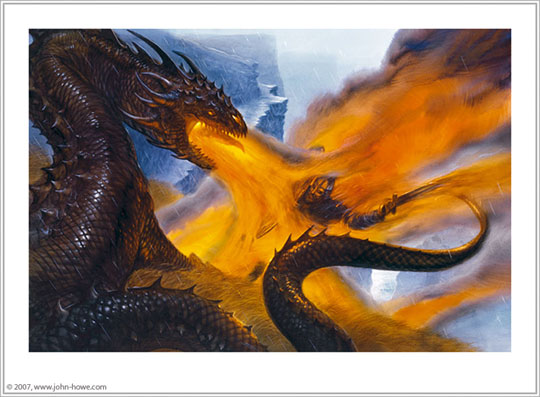Translation
Recordings
Beowulf's Flaw, and an Old Dichotomy
Striking at the Heart of the Poem
Closing
 |
Back To Top
Abstract
Wiglaf’s valor inspires Beowulf, but this leads to the revelation of the truth about Beowulf and his swords.
Back To Top
Translation
"Flame in a wave advanced,
burned the shield up to the boss; mail coat could not
for the young spear-warrior provide help,
but the man of youth under his kinsman’s shield
valiantly went on, when his own was
by flame destroyed. Then the war king again set
his mind on glory, struck with great strength
with the war sword, so that it in the dragon’s head stuck
and impelled hostility; Naegling broke,
failed at battle the sword of Beowulf, ancient
and grey-coloured. To him it was not granted by
fate that his sword’s edge may be a help at battle;
it was in his too strong hand, he who did so with
every sword, as I have heard, the stroke overtaxed
it, when he to battle bore any weapon wondrously
hard; it was not for him at all the better."
(Beowulf ll.2672b-2687)
Back To Top
Recordings
Old English:
Modern English:
Back To Top
Beowulf's Flaw, and an Old Dichotomy
All heroes need a flaw.
Eddard Stark in the Song of Ice and Fire was simply too noble, Link in the Legend of Zelda games is always inexperienced, and Beowulf can’t effectively wield swords. Beowulf's particular weakness is especially interesting in relation to the rest of the poem.
On the one hand, it’s potentially a great reflection of Beowulf’s name, whether it means “bear” (bee-wolf), or is simply “wolf.” His being unable to use swords effectively (almost pervasively a symbol of cultivated, human nobility) plays well to his animalistic aspect.
Rather than fighting like a civilized man with sword and shield, Beowulf instead fights bare handed, and is indeed the better for it. After all, defeating Grendel empty-handed is a much more boast-worthy feat than defeating him with a sword, not necessarily because of the strength that it requires, but because it plays so well into the mythology around Grendel as a monster who resists iron weapons.
However, it also implies that Beowulf is somehow on a level with Grendel, who, as it is noted, "scorns/in his reckless way to use weapons" ("þæt se ǣglǣca/for his won-hȳdum wǣpna ne recceð"(ll.433-434)).
In this way, Beowulf’s prowess in unarmed combat speaks to something uncivilized in him that he's note entirely capable of controlling. After his fight with Grendel, he doesn't seem to take up sword and shield to the same effect again (after Grendel we hear no more of "sea-brutes" ("niceras" (l.422)) or trolls ("eotena" (l.421))). Except of course, in his final, fatal battle with the dragon.
Back To Top
Striking at the Heart of the Poem
The fact that the whole poem is essentially an elegy to Beowulf and the Geatish (probably, by proxy, Anglo-Saxon) culture that he is so much a part of, while also presenting Beowulf as uncivilized in war (something uncivilized in itself) might just be the strongest argument for Beowulf’s really being about the Anglo-Saxons transitioning from their own traditions to something more Christian. The brutality of empty-handed combat gives way to something regarded as more civil.
The way of the sword (very obviously a cross, if the blade is stuck into the ground), is left in the absence of the way of the brutal fist. But even the way of the sword fades, if you look beyond the far end of the poem, as the Geats are prophesied to soon meet their end as a nation (ll.3010-3030).
So in addition to elegy, the poem is also apocalyptic, indicating the end of warfare, the way of the sword, for one of the many groups in early medieval Europe. Perhaps, from a Christian perspective, this is meant to point towards a Utopian future, or Second Coming, that is inevitable if the old ways are left behind and new ones are adapted.
Back To Top
Closing
Check back next week for more of Isidore’s colorful explanations, and for the climax of the battle between team Beowulf and the dragon.
Back To Top
No comments:
Post a Comment